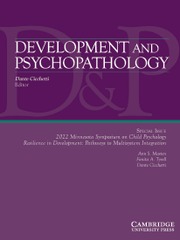No CrossRef data available.
Article contents
Trajectories of resilience among Chinese adolescents: Effects of gratitude and perceived stress
Published online by Cambridge University Press: 15 August 2025
Abstract
To fully understand resilience and to inform resilience-promoting interventions, it is important to explore how resilience develops and the factors that influence it. Using a multidimensional approach that considers both well-being resilience (higher than expected wellbeing after adversity) and depression resilience (lower than expected depression after adversity), this study examined resilience trajectories among Chinese 0adolescents and the associations of gratitude and perceived stress with resilience trajectories. Data from a four-wave longitudinal study were analyzed from 563 Chinese adolescents (mean age at Time 1 = 12.83 years, 51.87% boys). Parallel-process latent class growth modeling identified four distinct trajectories of resilience development: flourishing resilience (increasing resilience; 21.67%), increasing wellbeing resilience but decreasing depression resilience (28.24%), declining resilience (29.48%), and increasing depression resilience but decreasing wellbeing resilience (20.61%). Gratitude was associated with greater odds of being in the flourishing resilience group. Furthermore, perceived stress was associated with lower odds of being in the flourishing resilience group and higher odds of being in the declining resilience group. The findings suggest that resilience is a dynamic and multidimensional construct with highly heterogeneous developmental trajectories. Gratitude and perceived stress may be effective targets for interventions to enhance adolescent resilience.
Information
- Type
- Regular Article
- Information
- Copyright
- © The Author(s), 2025. Published by Cambridge University Press


